Abstract
OBJECTIVE: The aims of this study were to analyze the natural history of patients with pseudomyxoma peritonei (PMP), evaluate clinical and pathologic variables as prognostic indicators, and review the authors' experience with different treatments. SUMMARY BACKGROUND DATA: PMP is an unusual form of intra-abdominal neoplasm that presents with large amounts of extracellular mucin. Diffuse peritoneal spread occurs in most patients with PMP, and distant metastasis is infrequent. Debulking surgery, radiation therapy (radioisotope and external beam), and chemotherapy (both intraperitoneal and systemic) have all been advocated for optional patient management, but the variability of patients studied, the small patient numbers, and the prolonged course of this disease make the evaluation of results difficult. METHODS: Fifty-six patients were treated for PMP at the Mayo Clinic between 1957 and 1983. The data were collected retrospectively. Univariate (log-rank test) and multivariate (Cox regression model) analyses were performed for disease recurrence and patient survival. RESULTS: Most patients with PMP had carcinomas of the appendix (52%) or ovary (34%). All gross tumor could be removed only in the 34% of patients with limited disease. Although tumor progression occurred in 76% of patients, the 1-, 5-, and 10-year survival rates were 98%, 53%, and 32%, respectively. Adverse predictors of patient survival included weight loss (p = 0.001), abdominal distention (p = 0.004), use of systemic chemotherapy (p = 0.005), diffuse disease (p = 0.038), and invasion of other organs (p = 0.04). Intraperitoneal chemotherapy (p = 0.009) and radioisotopes (p = 0.0043) both were effective in prolonging the recurrence time of symptomatic PMP. CONCLUSIONS: Although PMP is an indolent disease, aggressive surgical debulking followed by intraperitoneal radioisotopes and/or chemotherapy should be considered because of the diffuse peritoneal involvement.
Full text
PDF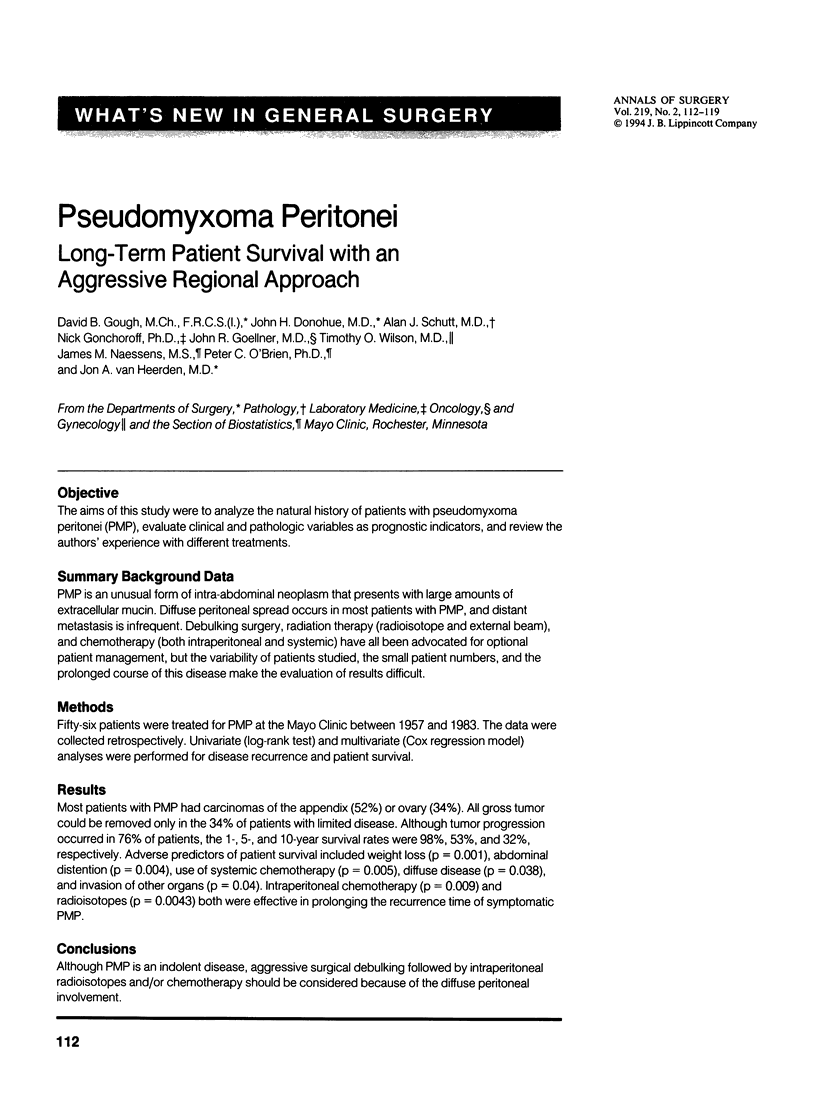
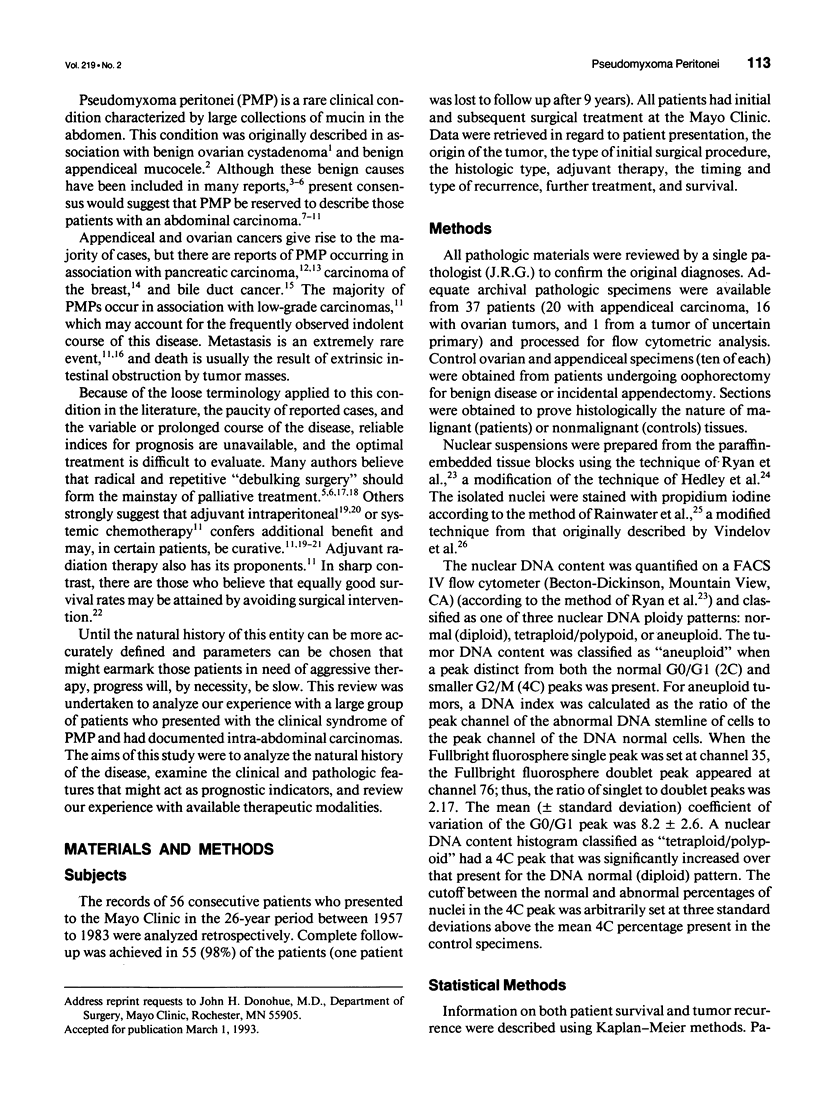
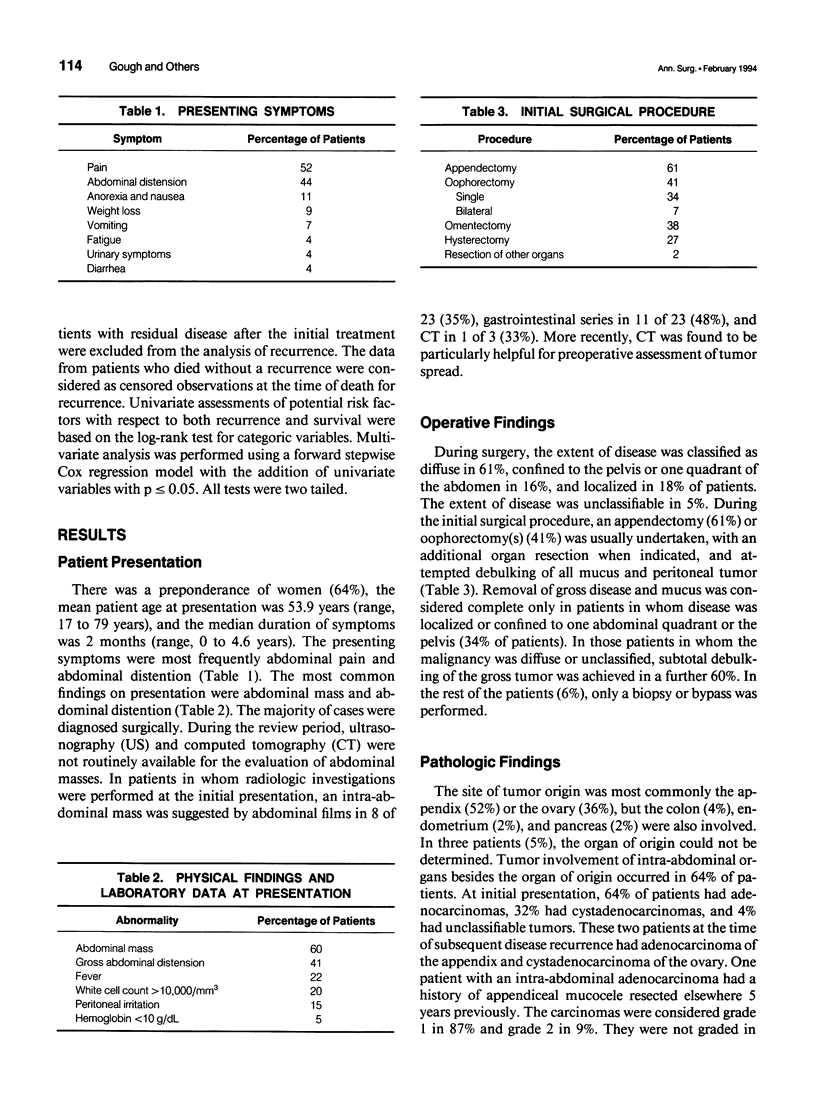
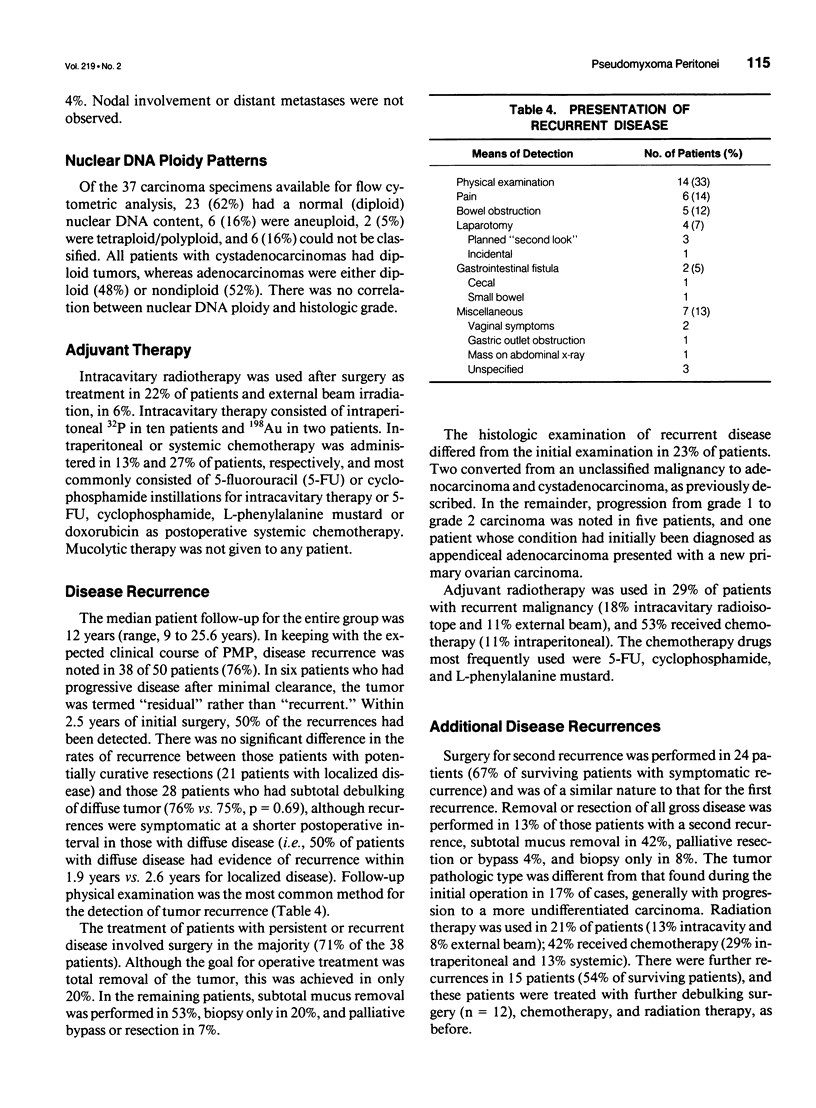
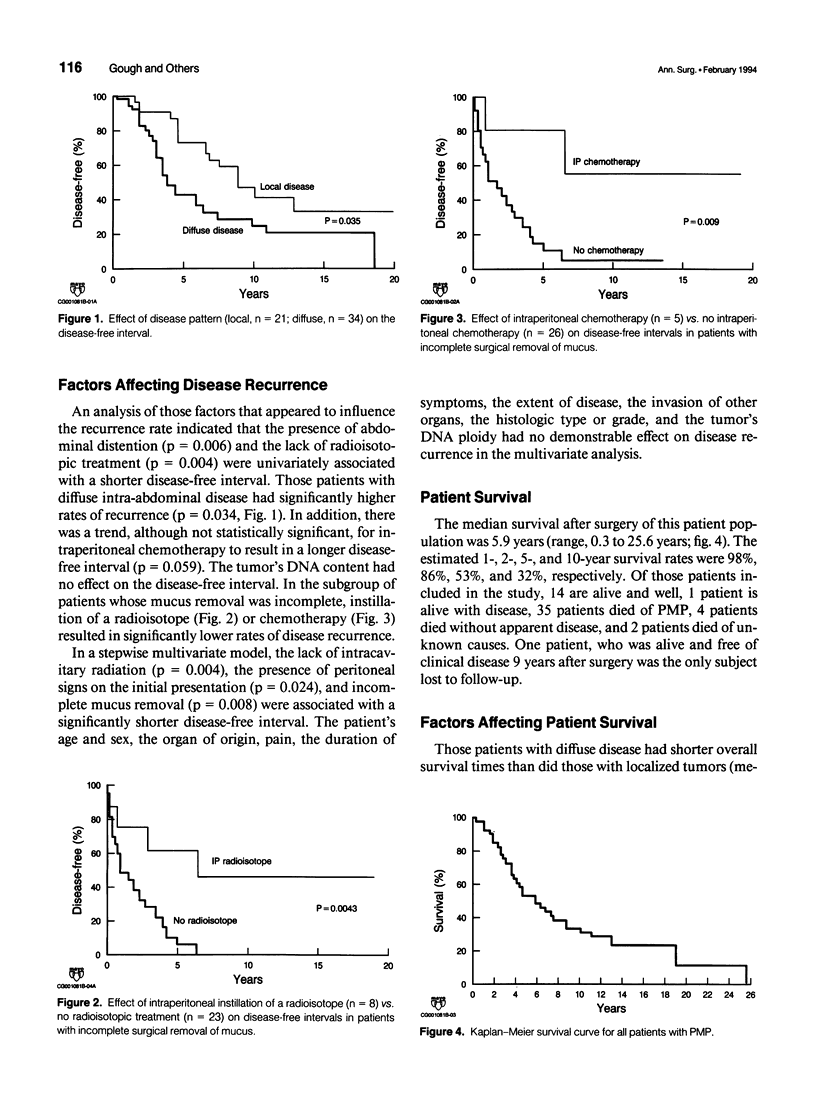

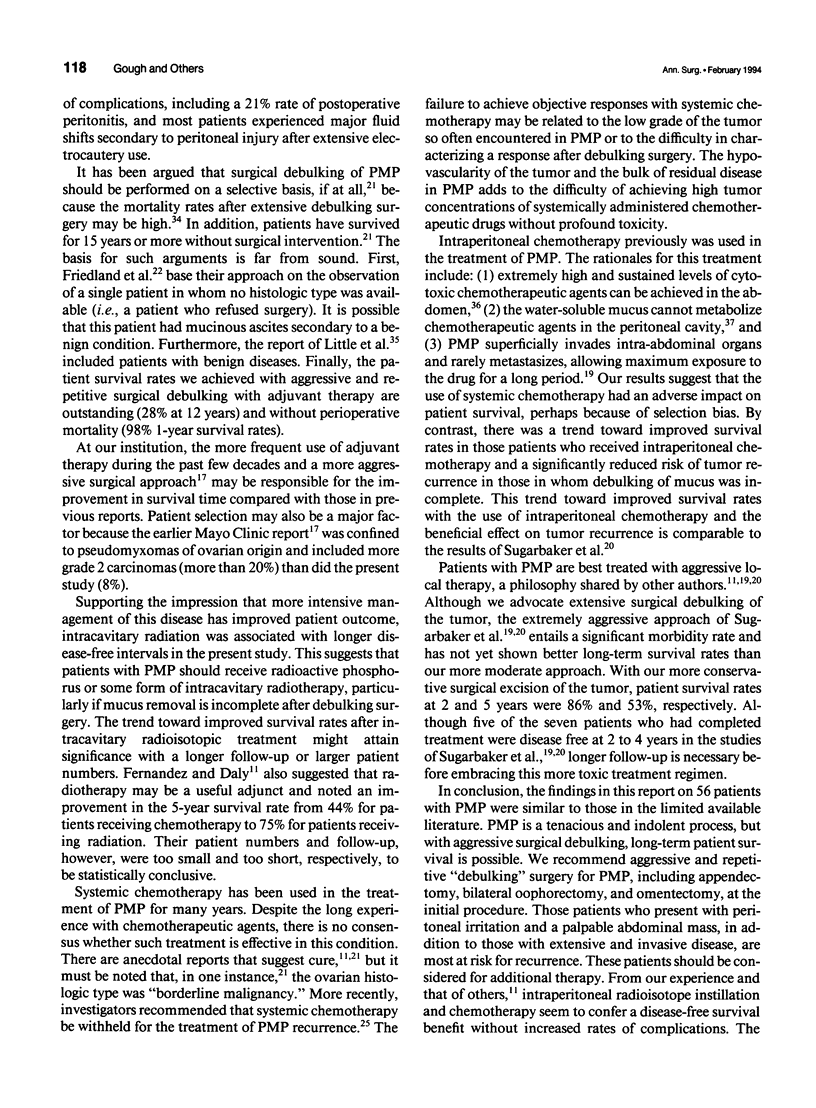
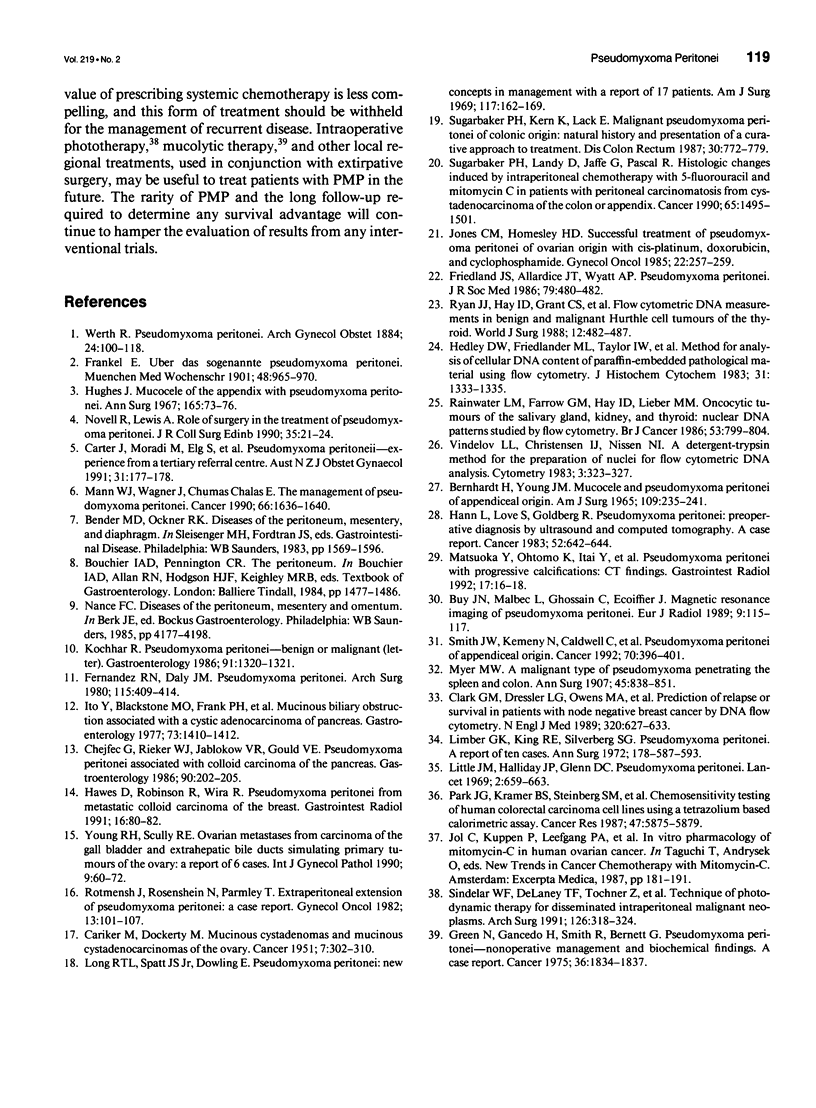
Selected References
These references are in PubMed. This may not be the complete list of references from this article.
- BERNHARDT H., YOUNG J. M. MUCOCELE AND PSEUDOMYXOMA PERITONEI OF APPENDICEAL ORIGIN. CLINICOPATHOLOGIC ASPECTS. Am J Surg. 1965 Feb;109:235–241. doi: 10.1016/s0002-9610(65)80151-9. [DOI] [PubMed] [Google Scholar]
- Buy J. N., Malbec L., Ghossain M. A., Guinet C., Ecoiffier J. Magnetic resonance imaging of pseudomyxoma peritonei. Eur J Radiol. 1989 May;9(2):115–118. [PubMed] [Google Scholar]
- CARIKER M., DOCKERTY M. Mucinous cystadenomas and mucinous cystadenocarcinomas of the ovary; a clinical and pathological study of 355 cases. Cancer. 1954 Mar;7(2):302–310. doi: 10.1002/1097-0142(195403)7:2<302::aid-cncr2820070214>3.0.co;2-9. [DOI] [PubMed] [Google Scholar]
- Carter J., Moradi M. M., Elg S., Byers L., Adcock L. A., Carson L. F., Prem K. A., Twiggs L. B. Pseudomyxoma peritonei--experience from a tertiary referral centre. Aust N Z J Obstet Gynaecol. 1991 May;31(2):177–178. doi: 10.1111/j.1479-828x.1991.tb01813.x. [DOI] [PubMed] [Google Scholar]
- Chejfec G., Rieker W. J., Jablokow V. R., Gould V. E. Pseudomyxoma peritonei associated with colloid carcinoma of the pancreas. Gastroenterology. 1986 Jan;90(1):202–205. doi: 10.1016/0016-5085(86)90094-6. [DOI] [PubMed] [Google Scholar]
- Clark G. M., Dressler L. G., Owens M. A., Pounds G., Oldaker T., McGuire W. L. Prediction of relapse or survival in patients with node-negative breast cancer by DNA flow cytometry. N Engl J Med. 1989 Mar 9;320(10):627–633. doi: 10.1056/NEJM198903093201003. [DOI] [PubMed] [Google Scholar]
- Fernandez R. N., Daly J. M. Pseudomyxoma peritonei. Arch Surg. 1980 Apr;115(4):409–414. doi: 10.1001/archsurg.1980.01380040037006. [DOI] [PubMed] [Google Scholar]
- Friedland J. S., Allardice J. T., Wyatt A. P. Pseudomyxoma peritonei. J R Soc Med. 1986 Aug;79(8):480–482. doi: 10.1177/014107688607900816. [DOI] [PMC free article] [PubMed] [Google Scholar]
- Green N., Gancedo H., Smith R., Bernett G. Pseudomyxoma peritonei-nonoperative management and biochemical findings. A case report. Cancer. 1975 Nov;36(5):1834–1837. doi: 10.1002/1097-0142(197511)36:5<1834::aid-cncr2820360539>3.0.co;2-6. [DOI] [PubMed] [Google Scholar]
- Hann L., Love S., Goldberg R. P. Pseudomyxoma peritonei: preoperative diagnosis by ultrasound and computed tomography. A case report. Cancer. 1983 Aug 15;52(4):642–644. doi: 10.1002/1097-0142(19830815)52:4<642::aid-cncr2820520412>3.0.co;2-7. [DOI] [PubMed] [Google Scholar]
- Hawes D., Robinson R., Wira R. Pseudomyxoma peritonei from metastatic colloid carcinoma of the breast. Gastrointest Radiol. 1991 Winter;16(1):80–82. doi: 10.1007/BF01887311. [DOI] [PubMed] [Google Scholar]
- Hedley D. W., Friedlander M. L., Taylor I. W., Rugg C. A., Musgrove E. A. Method for analysis of cellular DNA content of paraffin-embedded pathological material using flow cytometry. J Histochem Cytochem. 1983 Nov;31(11):1333–1335. doi: 10.1177/31.11.6619538. [DOI] [PubMed] [Google Scholar]
- Hughes J. Mucocele of the appendix with pseudomyxoma peritonei: a benign or malignant disease? Ann Surg. 1967 Jan;165(1):73–76. doi: 10.1097/00000658-196701000-00010. [DOI] [PMC free article] [PubMed] [Google Scholar]
- Ito Y., Blackstone M. O., Frank P. H., Skinner D. B. Mucinous biliary obstruction associated with a cystic adenocarcinoma of the pancreas. Gastroenterology. 1977 Dec;73(6):1410–1412. [PubMed] [Google Scholar]
- Jones C. M., 3rd, Homesley H. D. Successful treatment of pseudomyxoma peritonei of ovarian origin with cis-platinum, doxorubicin, and cyclophosphamide. Gynecol Oncol. 1985 Oct;22(2):257–259. doi: 10.1016/0090-8258(85)90035-6. [DOI] [PubMed] [Google Scholar]
- Kochhar R. Pseudomyxoma peritonei--benign or malignant. Gastroenterology. 1986 Nov;91(5):1320–1321. doi: 10.1016/s0016-5085(86)80042-7. [DOI] [PubMed] [Google Scholar]
- Limber G. K., King R. E., Silverberg S. G. Pseudomyxoma peritonaei: a report of ten cases. Ann Surg. 1973 Nov;178(5):587–593. doi: 10.1097/00000658-197311000-00006. [DOI] [PMC free article] [PubMed] [Google Scholar]
- Little J. M., Halliday J. P., Glenn D. C. Pseudomyxoma peritonei. Lancet. 1969 Sep 27;2(7622):659–663. doi: 10.1016/s0140-6736(69)90374-2. [DOI] [PubMed] [Google Scholar]
- Long R. T., Spratt J. S., Jr, Dowling E. Pseudomyxoma peritonei. New concepts in management with a report of seventeen patients. Am J Surg. 1969 Feb;117(2):162–169. doi: 10.1016/0002-9610(69)90300-6. [DOI] [PubMed] [Google Scholar]
- Mann W. J., Jr, Wagner J., Chumas J., Chalas E. The management of pseudomyxoma peritonei. Cancer. 1990 Oct 1;66(7):1636–1640. doi: 10.1002/1097-0142(19901001)66:7<1636::aid-cncr2820660731>3.0.co;2-n. [DOI] [PubMed] [Google Scholar]
- Matsuoka Y., Ohtomo K., Itai Y., Nishikawa J., Yoshikawa K., Sasaki Y. Pseudomyxoma peritonei with progressive calcifications: CT findings. Gastrointest Radiol. 1992 Winter;17(1):16–18. doi: 10.1007/BF01888499. [DOI] [PubMed] [Google Scholar]
- Myer M. W. A MALIGNANT TYPE OF PSEUDOMYXOMA PERITONEI PENETRATING THE SPLEEN AND COLON. Ann Surg. 1907 Jun;45(6):838–851. doi: 10.1097/00000658-190706000-00006. [DOI] [PMC free article] [PubMed] [Google Scholar]
- Novell R., Lewis A. Role of surgery in the treatment of pseudomyxoma peritonei. J R Coll Surg Edinb. 1990 Feb;35(1):21–24. [PubMed] [Google Scholar]
- Park J. G., Kramer B. S., Steinberg S. M., Carmichael J., Collins J. M., Minna J. D., Gazdar A. F. Chemosensitivity testing of human colorectal carcinoma cell lines using a tetrazolium-based colorimetric assay. Cancer Res. 1987 Nov 15;47(22):5875–5879. [PubMed] [Google Scholar]
- Rainwater L. M., Farrow G. M., Hay I. D., Lieber M. M. Oncocytic tumours of the salivary gland, kidney, and thyroid: nuclear DNA patterns studied by flow cytometry. Br J Cancer. 1986 Jun;53(6):799–804. doi: 10.1038/bjc.1986.135. [DOI] [PMC free article] [PubMed] [Google Scholar]
- Rotmensch J., Rosenshein N., Parmley T. Extraperitoneal extension of pseudomyxoma peritonei: a case report. Gynecol Oncol. 1982 Feb;13(1):101–107. doi: 10.1016/0090-8258(82)90014-2. [DOI] [PubMed] [Google Scholar]
- Ryan J. J., Hay I. D., Grant C. S., Rainwater L. M., Farrow G. M., Goellner J. R. Flow cytometric DNA measurements in benign and malignant Hürthle cell tumors of the thyroid. World J Surg. 1988 Aug;12(4):482–487. doi: 10.1007/BF01655427. [DOI] [PubMed] [Google Scholar]
- Sindelar W. F., DeLaney T. F., Tochner Z., Thomas G. F., Dachoswki L. J., Smith P. D., Friauf W. S., Cole J. W., Glatstein E. Technique of photodynamic therapy for disseminated intraperitoneal malignant neoplasms. Phase I study. Arch Surg. 1991 Mar;126(3):318–324. doi: 10.1001/archsurg.1991.01410270062011. [DOI] [PubMed] [Google Scholar]
- Smith J. W., Kemeny N., Caldwell C., Banner P., Sigurdson E., Huvos A. Pseudomyxoma peritonei of appendiceal origin. The Memorial Sloan-Kettering Cancer Center experience. Cancer. 1992 Jul 15;70(2):396–401. doi: 10.1002/1097-0142(19920715)70:2<396::aid-cncr2820700205>3.0.co;2-a. [DOI] [PubMed] [Google Scholar]
- Sugarbaker P. H., Kern K., Lack E. Malignant pseudomyxoma peritonei of colonic origin. Natural history and presentation of a curative approach to treatment. Dis Colon Rectum. 1987 Oct;30(10):772–779. doi: 10.1007/BF02554625. [DOI] [PubMed] [Google Scholar]
- Sugarbaker P. H., Landy D., Jaffe G., Pascal R. Histologic changes induced by intraperitoneal chemotherapy with 5-fluorouracil and mitomycin C in patients with peritoneal carcinomatosis from cystadenocarcinoma of the colon or appendix. Cancer. 1990 Apr 1;65(7):1495–1501. doi: 10.1002/1097-0142(19900401)65:7<1495::aid-cncr2820650708>3.0.co;2-1. [DOI] [PubMed] [Google Scholar]
- Vindeløv L. L., Christensen I. J., Nissen N. I. A detergent-trypsin method for the preparation of nuclei for flow cytometric DNA analysis. Cytometry. 1983 Mar;3(5):323–327. doi: 10.1002/cyto.990030503. [DOI] [PubMed] [Google Scholar]
- Young R. H., Scully R. E. Ovarian metastases from carcinoma of the gallbladder and extrahepatic bile ducts simulating primary tumors of the ovary. A report of six cases. Int J Gynecol Pathol. 1990;9(1):60–72. doi: 10.1097/00004347-199001000-00006. [DOI] [PubMed] [Google Scholar]


